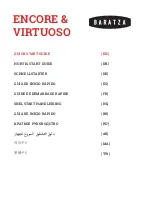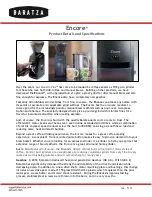
12
GB
Flange arrangement when using a depressed-
centre cutting wheel (Fig. 8)
a) Clamping flange
b) Flange nut
Flange arrangement when using a straight
cutting wheel (Fig. 9)
a) Clamping flange
b) Flange nut
6.4 MOTOR
It is vital for the motor to be well ventilated during
operation. Be sure, therefore, to keep the ventilation
holes clean at all times.
6.5 GRINDING WHEELS
Never use a grinding or cutting wheel bigger than
the specified diameter.
Before using a grinding or cutting wheel, check
its rated speed.
The wheel´s rated speed must be higher than the
idle speed of the right-angle grinder.
Use only grinding and cutting wheels that are
approved for a minimum speed of 11000 rpm
and a peripheral speed of 80 m/sec.
Check the direction of rotation when you use
diamond cutting wheels. The directional arrow on
the diamond cutting wheel must point in the
direction in which the tool rotates.
Take special care that the grinding/sanding wheels
are properly stored and transported. Ensure that the
grinding/sanding wheels are never exposed to shock,
jolts or sharp edges (for example during transport or
storage in a toolbox). This could cause damage (such
as cracks) to the grinding/sanding wheels and place
the user in serious danger.
6.6 OPERATING MODES
6.6.1 Rough grinding
Caution: Use the safety device for
sanding/grinding
(included in items supplied)
.
For the best rough grinding results, hold the grinding
wheel at an angle of between 30° and 40° to the
workpiece surface and guide back and forth over the
workpiece in steady movements.
6.6.2 Cutting
Caution: Use the safety device for abrasive
cutting
(available as accessory, see 8.4)
When you use the right-angle grinder for cutting
purposes, avoid tilting it in the cutting plane. The
cutting wheel must have a clean cutting edge.
A diamond cutting wheel is best used to cut hard
stone.
It is prohibited to use the machine on
asbestos materials!
Never use a cutting wheel for rough grinding.
7. Replacing the power cable
If the power cable for this equipment is damaged, it
must be replaced by the manufacturer or its after-
sales service or similarly trained personnel to avoid
danger.
8. Cleaning, maintenance and ordering
of spare parts
Always pull out the mains power plug before starting
any cleaning work.
8.1 Cleaning
Keep all safety devices, air vents and the motor
housing free of dirt and dust as far as possible.
Wipe the equipment with a clean cloth or blow it
with compressed air at low pressure.
We recommend that you clean the device
immediately each time you have finished using it.
Clean the equipment regularly with a moist cloth
and some soft soap. Do not use cleaning agents
or solvents; these could attack the plastic parts
of the equipment. Ensure that no water can seep
into the device.
8.2 Carbon brushes
In case of excessive sparking, have the carbon
brushes checked only by a qualified electrician.
Important! The carbon brushes should not be rep
laced by anyone but a qualified electrician.
8.3 Maintenance
There are no parts inside the equipment which
require additional maintenance.
8.4 Ordering replacement parts
Please quote the following data when ordering
replacement parts:
Type of machine
Article number of the machine
Identification number of the machine
Replacement part number of the part required
For our latest prices, information and order details
please go to www.isc-gmbh.info
Safety guard for cutting (Art. No.: 44.500.14)
Anleitung_E_WS_600_SPK7:_ 13.10.2010 9:47 Uhr Seite 12













































